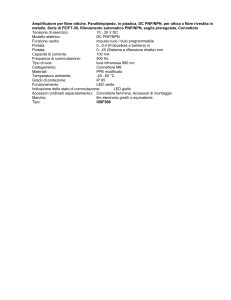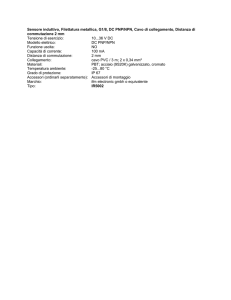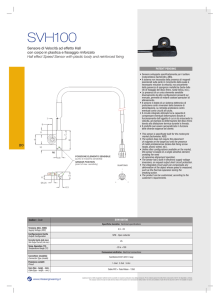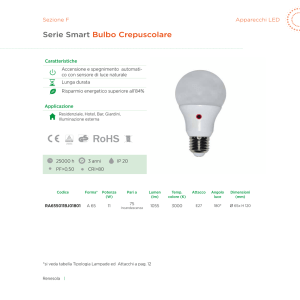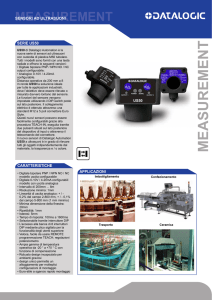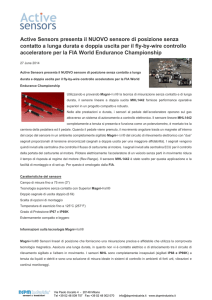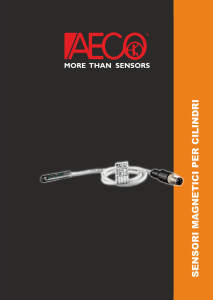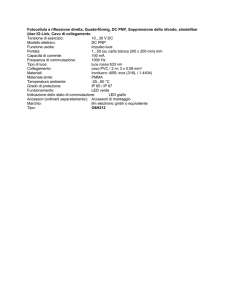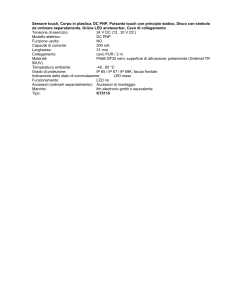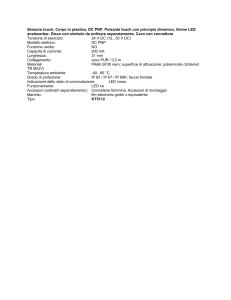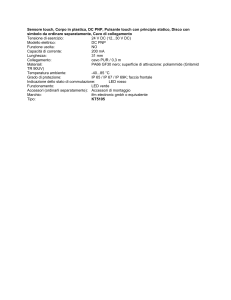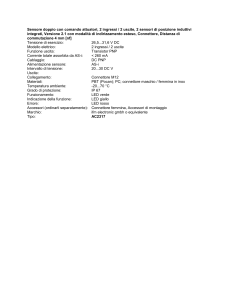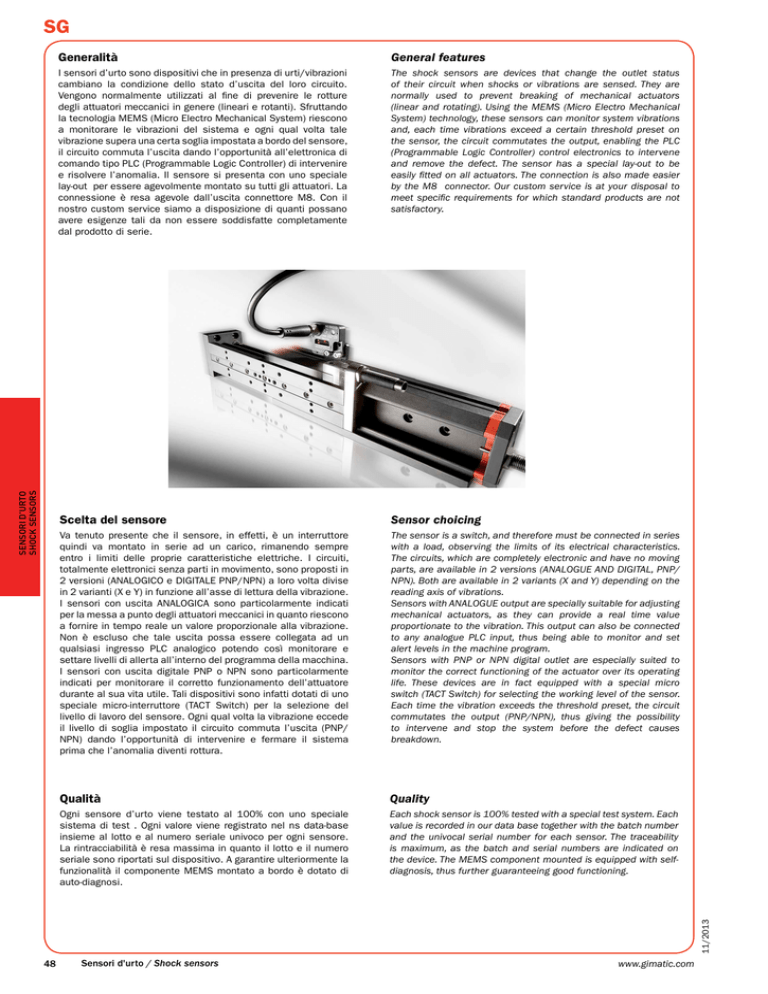
Sensori d’urto
Generalità
General features
I sensori d’urto sono dispositivi che in presenza di urti/vibrazioni
cambiano la condizione dello stato d’uscita del loro circuito.
Vengono normalmente utilizzati al fine di prevenire le rotture
degli attuatori meccanici in genere (lineari e rotanti). Sfruttando
la tecnologia MEMS (Micro Electro Mechanical System) riescono
a monitorare le vibrazioni del sistema e ogni qual volta tale
vibrazione supera una certa soglia impostata a bordo del sensore,
il circuito commuta l’uscita dando l’opportunità all’elettronica di
comando tipo PLC (Programmable Logic Controller) di intervenire
e risolvere l’anomalia. Il sensore si presenta con uno speciale
lay-out per essere agevolmente montato su tutti gli attuatori. La
connessione è resa agevole dall’uscita connettore M8. Con il
nostro custom service siamo a disposizione di quanti possano
avere esigenze tali da non essere soddisfatte completamente
dal prodotto di serie.
The shock sensors are devices that change the outlet status
of their circuit when shocks or vibrations are sensed. They are
normally used to prevent breaking of mechanical actuators
(linear and rotating). Using the MEMS (Micro Electro Mechanical
System) technology, these sensors can monitor system vibrations
and, each time vibrations exceed a certain threshold preset on
the sensor, the circuit commutates the output, enabling the PLC
(Programmable Logic Controller) control electronics to intervene
and remove the defect. The sensor has a special lay-out to be
easily fitted on all actuators. The connection is also made easier
by the M8 connector. Our custom service is at your disposal to
meet specific requirements for which standard products are not
satisfactory.
Scelta del sensore
Sensor choicing
Va tenuto presente che il sensore, in effetti, è un interruttore
quindi va montato in serie ad un carico, rimanendo sempre
entro i limiti delle proprie caratteristiche elettriche. I circuiti,
totalmente elettronici senza parti in movimento, sono proposti in
2 versioni (ANALOGICO e DIGITALE PNP/NPN) a loro volta divise
in 2 varianti (X e Y) in funzione all’asse di lettura della vibrazione.
I sensori con uscita ANALOGICA sono particolarmente indicati
per la messa a punto degli attuatori meccanici in quanto riescono
a fornire in tempo reale un valore proporzionale alla vibrazione.
Non è escluso che tale uscita possa essere collegata ad un
qualsiasi ingresso PLC analogico potendo così monitorare e
settare livelli di allerta all’interno del programma della macchina.
I sensori con uscita digitale PNP o NPN sono particolarmente
indicati per monitorare il corretto funzionamento dell’attuatore
durante al sua vita utile. Tali dispositivi sono infatti dotati di uno
speciale micro-interruttore (TACT Switch) per la selezione del
livello di lavoro del sensore. Ogni qual volta la vibrazione eccede
il livello di soglia impostato il circuito commuta l’uscita (PNP/
NPN) dando l’opportunità di intervenire e fermare il sistema
prima che l’anomalia diventi rottura.
The sensor is a switch, and therefore must be connected in series
with a load, observing the limits of its electrical characteristics.
The circuits, which are completely electronic and have no moving
parts, are available in 2 versions (ANALOGUE AND DIGITAL, PNP/
NPN). Both are available in 2 variants (X and Y) depending on the
reading axis of vibrations.
Sensors with ANALOGUE output are specially suitable for adjusting
mechanical actuators, as they can provide a real time value
proportionate to the vibration. This output can also be connected
to any analogue PLC input, thus being able to monitor and set
alert levels in the machine program.
Sensors with PNP or NPN digital outlet are especially suited to
monitor the correct functioning of the actuator over its operating
life. These devices are in fact equipped with a special micro
switch (TACT Switch) for selecting the working level of the sensor.
Each time the vibration exceeds the threshold preset, the circuit
commutates the output (PNP/NPN), thus giving the possibility
to intervene and stop the system before the defect causes
breakdown.
Qualità
Quality
Ogni sensore d’urto viene testato al 100% con uno speciale
sistema di test . Ogni valore viene registrato nel ns data-base
insieme al lotto e al numero seriale univoco per ogni sensore.
La rintracciabilità è resa massima in quanto il lotto e il numero
seriale sono riportati sul dispositivo. A garantire ulteriormente la
funzionalità il componente MEMS montato a bordo è dotato di
auto-diagnosi.
Each shock sensor is 100% tested with a special test system. Each
value is recorded in our data base together with the batch number
and the univocal serial number for each sensor. The traceability
is maximum, as the batch and serial numbers are indicated on
the device. The MEMS component mounted is equipped with selfdiagnosis, thus further guaranteeing good functioning.
11/2013
sensori d'urto
shock sensors
SG
Shock sensors
48
Sensori d'urto / Shock sensors
www.gimatic.com
SG
Codice sensore
Sensor code
Serie / Series
SG
3
N
2
-G
SG
Connessione /
3
Connection
Connettore M8 3 PIN /3 PIN M8 connector
Tipo circuito / Circuit type
A
N
M
Analog/ Analog
PNP/
NPN /
Tensione di alimentazione / Power supply
2
24 V dc
Personalizzazione / Personalization
Gimatic S.p.A
Codice connettore
Serie / Series
sensori d'urto
shock sensors
-G
Connector code
CF
G
M8
00
3
25
P
CF / CM
Tipo / Type
G
S
Metallica / Metal
Snap
Filetto / Thread
M8 M8 x 1
M12 M12 x 1
Angolo /Angle
00
90
0°
90°
Numero PIN / Number of PIN
2
3
Lunghezza cavo / Cable lenght
.... 0 m
25 2.5 m
Personalizzazione / Personalization
...
PVC
PUR
11/2013
P
www.gimatic.com
Sensori d'urto / Shock sensors
49
SG
Applicazione
Application
I sensori d’URTO possono essere montati su diversi
tipi di attuatori o sistemi automatici al fine di prevenire
malfunzionamenti che potrebbero pregiudicare il loro corretto
funzionamento meccanico. In genere quando un deceleratore è
rotto oppure non è tarato correttamente il livello delle vibrazioni
prodotte dall’urto cresce fino a rompere parti dell’attuatore o
addirittura del sistema sul quale è montato. Il sensore interviene
ogni qualvolta tale livello d’URTO supera la soglia pre-impostata
a bordo segnalando l’anomalia attraverso il LED ROSSO e
cambiando lo stato dell’uscita (PNP/NPN).
The SHOCK sensors are special shock detection sensors made to
avoid component failures on different kind of actuators. When a
shock absorber or a brake system is brocken the vibration goes
high till broke the actuator and other components around it. Eevry
time the value of the shock exceed the maximum pre-set value,
the sensor change the output status (RED LED is ON) giving the
possibility to stop the motion.
sensori d'urto
shock sensors
Esempio di utilizzo / Application example
Attuatori lineari / Linear actuators
Pinze/ Grippers
11/2013
Cilindrii / Cylinders
Attuatori rotanti / Rotary actuators
50
Sensori d'urto / Shock sensors
www.gimatic.com
SG
Configurazione sensore / Sensor layout
2
3
4
5
6
7
8
9
11
10
Connettore M8
M8 Connector
2
LED VERDE alimentazione
GREEN LED power supply indicator
3
LED ROSSO indicatore d’urto
RED LED shock indicator
4
LED GIALLI indicatori livello d’urto
YELLOW LED shock level indicators
5
Fori di fissaggio a passo micro-switch
Micro-switch fixing holes
6
Staffa di fissaggio 0÷90°
0÷90° slot bracket
7
Dadi di fissaggio M3 DIN439B INOX
M3 DIN439B INOX fixing nuts
8
Grani TCEI M2X4.5 DIN912 Z/B
TCEI M2X4.5 DIN912 Z/B screws
9
Adattatore per cave a "T"
"T" slot adapter
10
Interruttore di settaggio
Setting DIP switch
11
Viti di fissaggio TCEI M3X8 DIN912 Z/B
TCEI M3X8 DIN912 Z/B fixing screws
sensori d'urto
shock sensors
1
1
Procedura di settaggio / Setting procedure
•Fissare il sensore sulla parte fissa dell’attuatore in prossimità della
zona d’urto.
•Connettere ed alimentare il sensore ANALOGICO per verificare
direttamente l’intensità dell’urto.
•Mettere l’attuatore in movimento e regolare il moto nella migliore
condizione d’utilizzo mantenendo il livello delle vibrazioni il più basso
possibile.
Togliere il sensore ANALOGICO, connettere ed alimentare il sensore
DIGITALE. Il circuito andrà in condizione di auto-test e attendere fino
a che il LED ROSSO si sia spento.
Premere l'interruttore di settaggio (2 sec) al fine di selezionare il
livello di vibrazione che commuterà l'uscita.
Quando il LED ROSSO sarà spento saremo oltre il livello di vibrazione
dell’attuatore. Il sensore attiva il LED ROSSO e la relativa uscita
(PNP;NPN) ogni qual volta il livello delle vibrazioni supera il livello
pre-impostato sul sensore. Noi consigliamo di posizionarsi almeno a
2 livelli oltre la vibrazione del sistema.
•
•
•
•Fit the sensor on the motionless part of the actuator close to the
shock area.
•Connect and power supply the ANALOG sensor to check the shock
strength.
•Put in motion the actuator in the best dinamic condition keeping the
shocks as low as possibile.
•Remove the ANALOG sensor then fit and connect the DIGITAL one.
The circuit goes in self-test till the RED LED is OFF.
•Press the dip switch (2 sec) in order to select the output shock level.
•When the RED LED is OFF the vibration is under the level so every time
11/2013
it goes over the level the sensor switchs ON the output (PNP;NPN).
We suggest to step up 2 levels over the vibration.
www.gimatic.com
Sensori d'urto / Shock sensors
51
SG
SG
Sensore con conn. M8
Sensor with M8 connector
Tipo sensore
Sensor type
SG3A2-G
SG3N2-G
SG3M2-G
Uscita analogica
Analog output
Uscita PNP settabile su 10 livelli
10 levels settable PNP output
Uscita NPN settabile su 10 livelli
10 levels settable NPN output
Fondo scala
Full-scale
35 g
Assi di vibrazione
Vibration axis
X;Y
Tensione di alimentazione
Power supply
15 ÷ 30 Vdc
12 ÷ 30 Vdc
Corrente di commutazione
Switching current
max 0.5 A
Potenza (carico ohmico)
Power rating (ohmic load)
/
6W
Caduta di tensione
ON voltage drop
/
< 2V
0÷35 g (~270 mV/g)
2.0g; 2.5g; 3.3g; 4.2g; 5.3g; 7.4g; 9.5; 12.2g; 15.6; 20.0g
Punto di lavoro nominale
Nominal operate point
Tensione d'uscita ON
ON output voltage
0 ÷ 10 Vdc
+ Vcc (PNP)
Intensità d'urto massima
Absolute maximum range
4000 g
Tempo "ON"
"ON" time
/
200 ms
Frequenza di lavoro
Operating frequency
100 Hz
sensori d'urto
shock sensors
Temperatura di lavoro
Operating temperature
-10 ÷ 70°C
Vita elettrica
Life time
10° imp.
Protezione contro inversione di polarità
Polarity-reversal protection
SI/YES
Auto-test
Self-test
SI/YES
Grado di protezione
Environmental protection degree
IP67
Materiali corpo
Body materials
PA; AISI 303; OT63; gold plated brass
Normative di riferimento CE
CE reference norm
EN61000-6-2; EN61000-6-3; EN55022; EN61000-4-2; EN61000-4-3
+
g
Configurazioni circuitali
Wiring schematics
GND (NPN)
-
g
0...10Vcc
+
+Vcc
out
+Vcc
out
0
+
g
out
0
3,7
Marrone BW (+); Blu BL (-) Nero BK (OUT)
Brown BW (+); Blue BL (-) Black BK (OUT)
15
30
R3
6,5
Dimensioni (mm)
Dimensions (mm)
6,5
M8x1
2,5
7,5
3
9,5
11/2013
6
3
3,7
Ø3
Ø 2,5
15,8
9,5
30
R3
52
Sensori d'urto / Shock sensors
www.gimatic.com

